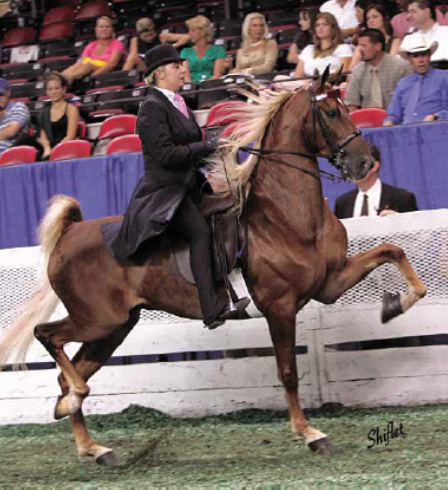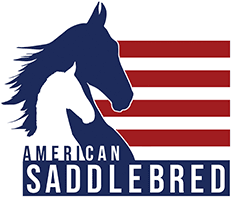
Continuing the Conversation - Futurities
By Bob Funkhouser - Reprinted by permission from Saddle Horse Report - 6/13/2022
This series of Continuing The Conversation has been dedicated to a subject that affects every part of the show horse industry – breeding. Even if you’ve never thought of raising a foal, the breeding game has an effect on several things if you’re a par-ticipant in the show ring, from the availability of horses to purchase to the price of those horses.
Like all industries, it’s about supply and demand. It’s a different line of stories for Continuing The Conversation but adding to the dilemma of the breeders is they can sell the top horses all day long but have a very hard time moving the middle and lower market horses as that demand is not there.
For this series of articles though, breeders with both large and small programs have shared their views on bloodlines, the importance of starting with a good mare, and the options of how you might breed that mare. This week we’ll look at the prize money pro-grams that are out there to help breeders recoup some of the cost of bringing the next generations of champions into the world.
The biggest burden for breeders of today’s show horse is cost. Not as much affordable land is available so that alone makes it harder for more people to be breeders. And since the use of transported semen was voted in a few decades ago, the costs to the breeder has risen as the involvement of technology has risen.
Prize money programs, especially Futurities, have been around for awhile, but today, more than ever, they are needed to make the adventure of breeding horses more palatable.
The ASHBA website describes the Futurity Prize Program as this: A futurity is a prize program for young horses, which awards purses made up of entry fees paid over a period of time by participants. Futurities are held to encourage the breeding and showing of American Saddlebred horses. Showing a foal in a futurity enhances its value and increases its earning potential; the value of the sire and dam may also be enhanced through the success of their progeny shown in futurities. Amateurs and juveniles, as well as professionals, have the opportunity to show young horses in futurities.
Additional programs that have been developed include the ASHBA Bill Wise Sweepstakes, the UPHA Classics and the All-American Cup. All of these have significant payouts for young horses. According to the ASHBA, $4,565,442 has been paid out in the National Futurities since 1999 and $3,463,870 has been awarded in the Sweepstakes program during that same time period.
“These programs really promote the breed. The prize money is the cherry on top,” said Grey Ridge Farm trainer Bret Day who has shown several young horses that have won substantial prize money in the above programs. “We look at the prestige that comes with those programs. The horses that come through these, the people have had the foresight to believe in their breeding program and nominate them. A lot of thought has been put into those foals. When I’m looking to pur-chase a young horse it’s a bonus for me to be able to promote to my client that a particular horse is eligible to win significant prize money.
“Last year when we won the ASHBA Weanling National Futurity it was with a colt who we raised his first three dams. His sire, Glamorous Nuts, is owned by our client Elizabeth Ghareeb and he is out of Brookhill’s Glam Slam who we trained for Elizabeth. There is a lot of pride when you raise a foal like this and had so much to do with its family. We also won $29,000 in that class so it was a pretty good payday.
“We take a page out of the Crabtree playbook where all of the clients had their show horses and a broodmare or two.”
Day also had advice for the amateur/owner/breeder who might not be sure of how to navigate all of these different pro-grams and what to do or not do.
“Talk to people who have been successful,” said Day. “Talk to several people and get different opinions and see what works for you. I don’t know one breeder in this industry who has been successful who wouldn’t help if anyone called them.”
Smith Lilly of Mercer Springs Farm is another trainer who is often seen leading a colt and showing young horses in a number of divisions. He too is an advocate of these prize money programs.
“I like to show a nice young horse and I like to win prize money,” replied Lilly when asked why he participated in these classes. “These classes give incentives to breeders to get some payback with significant prize money. This offsets some of their costs in raising a colt.
“Also, what I like about these classes is often they aren’t won by the upper one percent of our industry. Often, medium to small breeders win these big purses. Several small breeders have won the All-American Cup and do well in the futurities.
For instance, Larry Hartsock with us is a medium size breeder and he has won several world’s titles and quite a bit of money through the futurities. It has been very good for him.
“I particularly like the National Futurity to keep a horse eligible and after the in hand years they have the option to show in five different divisions. It gives the trainer more options of where to show that horse and get a return.
“Breeders have to look at their options and potential for return. There are several local futurities like the Carolinas, Wisconsin, and Indiana that pay very well. The local futurities are great places for the small and backyard breeder to showcase their work and get a return on their investment.
“As a trainer trying to buy a horse I don’t know if I lean towards horses that are nom-inated to programs, I like a nice horse no matter what it is. However, when it comes to getting the deal done, I think it’s easier when a horse is staked. As an agent, when it comes to splitting hairs and settling on a price it is easier to finish the deal when that extra earning power is there.”
Lilly also serves on the committee dealing with the ASHBA futurities and he’s announced some changes that should be favorable for the breeders. The National Three-Year-Old and Kentucky Futurities are being combined into one program. It will be a lot less paper work. The first crop will be this year’s yearlings.
“We are also adding a two-year-old three-gaited division to the futurity program,” said Lilly. “We have the two-year-old harness and now we will have the option of showing under saddle. I’d also like to see some of these local futurities offer classes up until their three-year-old years. People would keep them eli-gible and if they’re not interested in showing in hand or that colt isn’t an in hand type, they still have the three-year-old performance class to look forward to.
“We know we need to add some prize money to the lower ribbons in the futurity program. The top prize pays well in most of these but we want to get to where the colt that’s fourth or fifth can also get a nice enough return to make it worth their while. The money that Jenny Taylor and Todd Graham are getting added to some of the in hand classes from the Stallion Sweeps program is helping to pay better all the way through the ribbons.”
Speaking of not winning and still making it worthwhile, Kristen Bagdasarian had that exact experience with a two-year-old she bought from Todd Graham a while back.

“That fall we won a UPHA Classic ($425) at St Louis and finished the year reserve in the UPHA Three-Year-Old Park Pleasure Classic Championships ($6,510) at Kansas City. His four-year-old year we were reserve in the ASR Four-Year-Old Sweepstakes ($5,161).
“In 40 years of owning horses my parents had never gotten a return like we did on this horse. We also sold him well and he continued to do well. The thing is, we won that much money and only actually won a couple of classes.”
Her family’s Diamond View Farm continues to stand a stallion or two and raise several foals a year, in addition to foaling out mares for many clients. Bagdasarian has seen when these prize money programs can do for marketing her product and encourages all to do the same.
“I try to nominate about everything,” said Bagdasarian. “I also encourage my customers to nominate theirs. It has been a huge selling point for our colts. I also really like with the Four-Year-Old Sweepstakes at Louisville it gives you another option of where to show your young horse that week.”
Larry Hartsock was mentioned above by Smith Lilly. He is also a proponent of the programs and what they can do for a breeder’s program.
“We enjoy the babies and the futurities,” said Hartsock. “I would encourage everyone to nominate and show their babies. It lets people out there know what you’re raising. This year I nominated all of my babies, knowing they won’t all be shown as weanlings but hopefully they will be something by their two-year-old year.
“I think the futurity is a good place to start. “Overall, we’ve done well with the futurities. We’ve done good as far as prize money. It certainly doesn’t pay for it all, but it really helps. They have both the open and amateur futurity and you can show in both. That extra couple thousand you could win helps pay the bills. You can win a good little pot.”
Pride and prize money. They’re a good combination, especially in the competitive world of breeding and showing horses. There’s no masking it, breeding can range from expensive to extremely costly so the more chance at return the better your odds of making it enjoyable, not prohibitive.
For more information on the Futurity or Sweepstakes programs contact ASBHA, (859) 259-3899 or as Bret Day suggested, contact any breeder/trainer that you know that has been a part of these programs.
